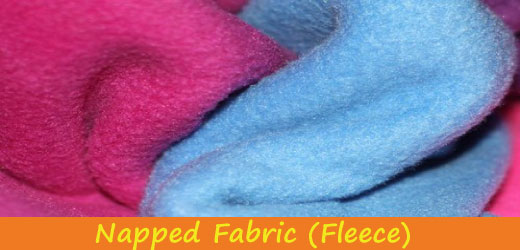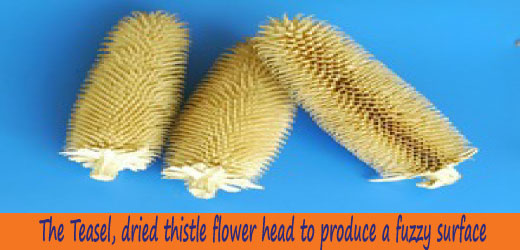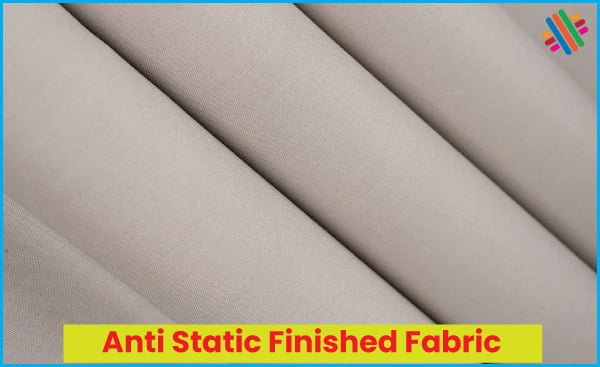What is Fabric Napping: Definition and Meaning
Last updated on July 15th, 2023 at 12:41 am
Definition of Fabric Napping
Fabric napping is a finishing process applied to textiles to create a raised surface of fine fibers on one or both sides of the fabric. It involves brushing or raising the fibers from the fabric surface, resulting in a soft, fuzzy texture. The raised fibers are often referred to as “nap.”
Reasons of Fabric Napping
Napping is chiefly used to obtain a relatively deep hairy surface, but the degree of depth depends upon the technique used. When a fabric is to be napped, the yarns intended for the construction of the cloth are given only a slack twist in the spinning process. The fabric is passed under a roller that has fine steel wires with small hooks on the ends. The hooks scrape the surface of the fabric pulling up fibre ends out of the yarn.
The fuzzy finish, produced by napping makes a soft fabric, which provides warmth because of the insulative air cells in the nap. The thicker the nap, the more air cells, and the warmer the fabric. In men’s suiting’s, where long wear is desired, a napped surface acts as a protection against objectionable luster. The fact that stains can be removed more readily from a napped surface is an additional advantage. On the other hand, napping may also serve to cover up a sleazy construction and weaving imperfections. It is generally considered that excessive napping tends to weaken the fabric, especially where a heavy nap has been produced, and to increase any propensity to pill.
Single napping signifies that both sides of a cloth have been napped in one direction; double napping signifies that both surfaces have been napped in opposite directions, which produces greater surface density, increased firmness, and greater warmth. Flannelette, wool flannel and duvetyn exemplify napped fabrics. Cotton and spun rayon fabrics are napped when a soft, fuzzy surface is desired.
Vegetable bars called teasels have been used for napping finer grades of wool fabrics. Long cylindrical rollers containing closely set wires, which act like brushes, also perform the teaseling operation. As the brushes slide over the revolving fabric, they pull the top fibres and raise the protruding ends above the surface of the cloth in the form of a fleece like nap. If a heavy nap is desired, teaseling is repeated several times.
Fabric Napping Techniques
Fabric napping is achieved through different techniques, including mechanical brushing, hand scraping, or chemical treatments. Here’s a brief overview of each method:
Mechanical Brushing
This method passes the fabric over rotating brushes or cylinders with wire bristles. The bristles catch and pull the fibres up, creating a nap on the fabric’s surface. The brushing action can be done in one direction (unidirectional) or multiple orders (multidirectional), depending on the desired effect.
Hand Scraping
Hand scraping involves using abrasive materials, such as sandpaper or emery cloth, to remove a small portion of the fabric’s surface fibers. This process is usually done on heavier fabrics like denim or corduroy to create a smoother and softer feel.
Chemical Treatments
Some fabrics undergo a chemical treatment called “chemical napping” or “sueding” to achieve a napped effect. Chemicals or enzymes are applied to the fabric, which weakens the surface fibers. Subsequently, the fabric is mechanically brushed to raise the weakened fibers, resulting in a soft and fuzzy texture.
Advantages of Fabric Napping
- It makes the fabric soft, resulting in highly comfortable to wear or use.
- It helps to trap air within the fibers, providing added insulation and warmth.
- It creates an attractive and visually exciting surface inside the outerwear when used as lining.
- It helps to protect the fabric surface from friction and abrasion, reducing wear and tear.
- It makes napped fabrics suitable for applications where noise reduction or soundproofing is desired, such as in upholstery or acoustic panels.
- It creates more surface area for moisture to be absorbed, making fabrics effective in wicking away sweat or water from the skin.
- It enhances the printability of fabrics by providing a textured surface for prints and patterns.






Your article provides insights that challenge traditional notions. Thank you for the fresh perspective!
I ‘d mention that most of us visitors are endowed to exist in a fabulous place with very many wonderful individuals with very helpful things.
Thank you a lot for providing individuals with a very spectacular possibility to read critical reviews from this site.
Thank you for shedding light on this topic. I found it thought-provoking.
Thanks for this practical advice on what is usually an overlooked topic. Can I link this with my people?